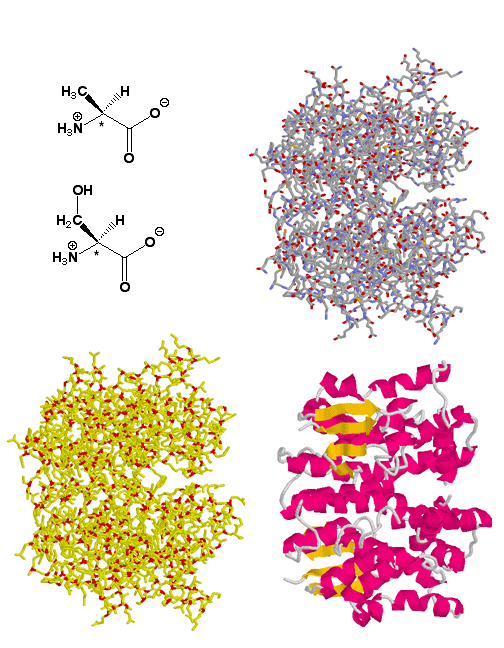Chirality - Biological Molecules (DNA)

Chirality - Biological Molecules (Proteins)

| Molecule of the Day: Chiral Biological Molecules | ||||||||||||
Chirality - Biological Molecules (DNA) |
||||||||||||
 |
||||||||||||
| Biological molecules are much larger than the molecules we have been talking about in organic chemistry so far. However, they are really just long chains of simpler building block molecules such as the nucleoside (cytosine) shown above on the left. There are three chiral centers in the molecule, indicated with an asterisk (*). Cytosine is one of the four so-called "nucleic acid bases" that are bonded "head-to-toe" to make up a strand of DNA. Two single strands come together to make the famous DNA double helix. From the point of view of this class, what is interesting about the DNA structure is chirality. Because the building blocks have multiple chiral centers and are found as single enantiomers in nature, the DNA structure itself is chiral and exists as a single enantiomer. The helix is a so-called "right-handed" helix. Like the threads on a screw, helices are chiral, and this form of DNA, called the "B-form" helix is the most commonly seen structure, and it is a chiral helix because the nucleic acid bases are chiral. | ||||||||||||
|
Chirality - Biological Molecules (Proteins) |
||||||||||||
|
|
||||||||||||
| Amino acids, like the two shown above (alanine and serine) each contain a chiral center as marked by the asterisk (*). In nature these are found as pure enantiomers. Amino acids are linked together in long chains that fold into complex stuctures called proteins. Like DNA, proteins are chiral structures because the amino acid building blocks are chiral. A typical protein is shown above. It is an enzyme called glutathione S-transferase. Enzymes catalyze chemical reactions, this one helps detoxify chemicals inside of cells. What is important to notice here is that the protein is actually a single enantiomer, even though it contains hundreds of chiral centers. The yellow model at the lower left has all of the chiral centers shown in red. The cartoon on the right shows how the chain folds. The magenta helices are chiral, just like the DNA helix is chiral. The bottom line is that biological molecules are chiral and found as single enantiomers even though they can have hundreds or thousands of chiral centers. This is because biological molecules are built from single enantiomers of chiral building block molecules (i.e. amino acids). Thus, biology is chiral, and stereochemistry is an extremely important part of biology. The most important consequence of this chirality in medicine is that drugs with chiral centers should be given as single enantiomers if possible, because the different enantiomers will interact differently with the chiral molecules in the body. | ||||||||||||